Are you looking for a simple way to make Korean Natural Farming’s Fermented Plant Juice? Then, this guide is for you.
Fermented Plant Juice (FPJ) is a microbe-rich, botanical extract made by fermenting plant materials. In Korean Natural Farming, FPJ is primarily used as liquid fertilizer and as a probiotic, sanitizer, and component in various concoctions.
In other words, the solution is full of microorganisms that can break down organic matter to make nutrients available to plants. It can also aid in digestion and protect plants from harmful pathogens.
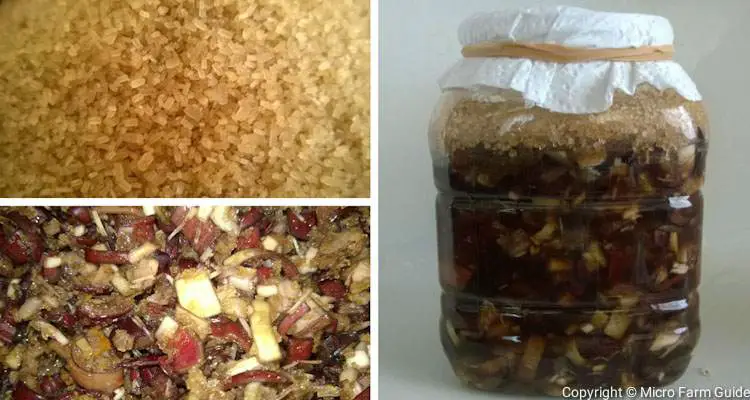
Now that we’re on the same page, here’s everything you will learn in this guide.
- Materials Needed To Make FPJ
- How To Make Fermented Plant Juice
- What Are The Best Plants For FPJ?
- Uses And Benefits Of Fermented Plant Juice
- How Do You Apply FPJ?
- Disadvantages Of Fermented Plant Juice
Let’s get brewing!
Materials Needed To Make Fermented Plant Juice
Before we get started, here’s a list of equipment and materials you’ll need to make FPJ. I did not include exact measurements since you have to adjust these to make as much or as little as you need.
| Items | Notes |
| Plant Material | Any fast-growing, non-poisonous plant |
| Sharp Knife | A pair of scissors can substitute |
| Brown-Sugar | Equal the weight of planting material, plus enough to cover the surface |
| Scale | Digital or analog kitchen scales will work |
| Large Container | A large-mouth glass container is best, but plastic or ceramic is ok |
| Paper Towels | Wide enough to cover the mouth of bottles |
| Rubber Band | Use string if not available |
| Storage Containers | Glass or plastic bottles will do |
| Strainer | Fine mesh or piece of cloth |
| Cupboard | A dark well-ventilator cupboard or large cardboard box |
Optional: Use food-safe gloves if you intend to use them as a probiotic. You may also wish to have some vinegar handy to help clean spills and repel ants.
Note: Don't worry if you cannot use the entire mixture at once. You can store Fermented Plant Juice for a long time. However, you’ll need to ensure that you store it properly.
How To Make Fermented Plant Juice
In Korean Natural Farming, we use sugar to extract nutrients from plant materials. This mixture provides food and a suitable environment for microorganisms to multiple. Follow the steps below to create your first batch of FPJ.
1. Collect The Ingredients And Equipment
To make FPJ, you need two main ingredients; plant materials and brown sugar. You can use just about any plants that you have available, provided they are not poisonous.
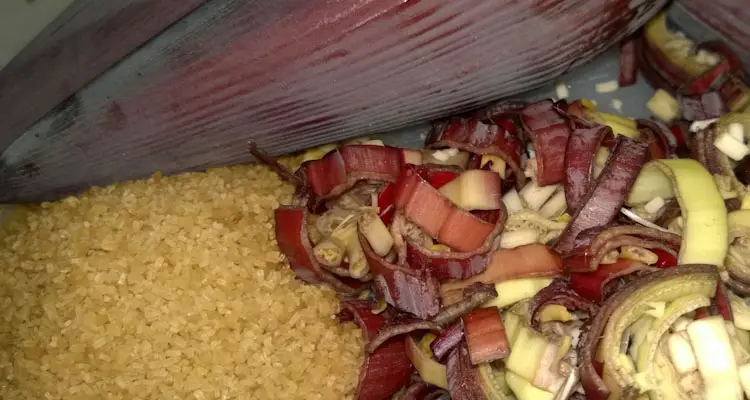
I’ll be using banana flowers for this example since we have a lot. We can safely remove them after the bunch of bananas develops on the plant. I’ve included a list of other plants you can use below.
Ideally, you should buy brown, organic cane sugar for this recipe. Don’t worry if this is not available. Any brown sugar you find at the supermarket will do.
Note: You should collect plants in the early morning, preferably before sunrise. Wait two to three days if there was heavy rainfall. Avoid collecting plants from polluted areas such as the side of busy roads.
2. Cut, Weigh, and Mix Ingredients
Use a sharp knife to cut the plant materials into small pieces about 1 inch long. You can use scissors to cut smaller plants such as Purslane and Moringa.
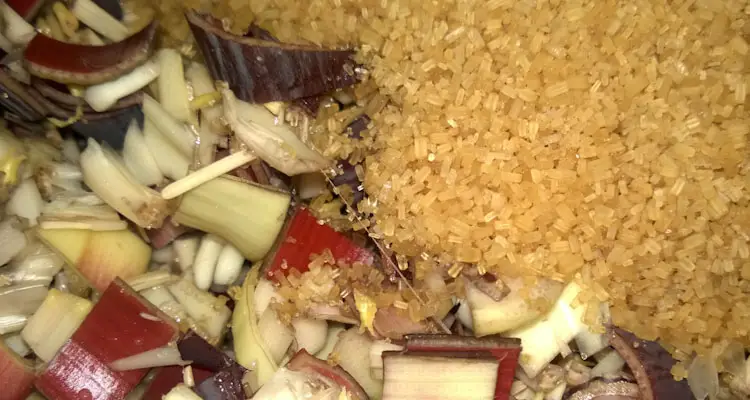
Weight the cut plant materials and place them into a container. Add an equal amount of brown sugar. For example, if you use 2 Lbs plant materials, add 2 Lbs Brown Sugar.
Mix the two ingredients well until the sugar coats the plant materials. While you’re mixing, the sugar will start to extract liquid from the plant material, creating a sticky solution.
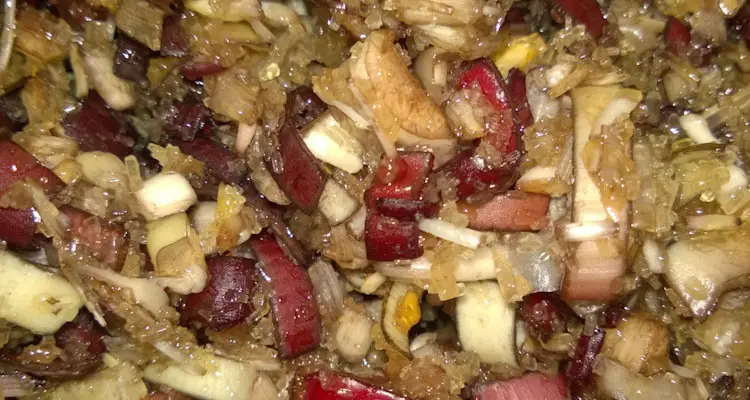
Note: Please do not wash the plants with water. Simply shake to remove soil. You should use a food-safe glove if possible. Ensure the containers are clean and dry before mixing.
3. Add To Fermenting Container
Pour the mixture into the large-mouth bottle. You can use a food-safe, plastic container, but glass is ideal. The larger the mouth, the easier it is to work with.
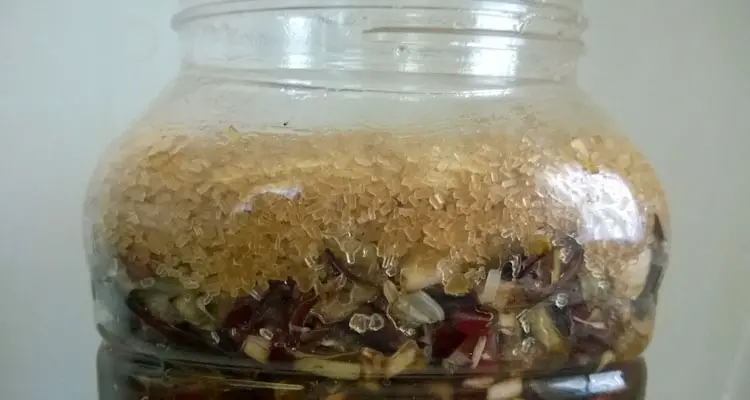
Press mixture down gently, then adds a layer of sugar on top. This layer prevents the plant material from interacting with the air and provides additional food if necessary.
Clean the outside of the container, removing any sticky residue. You can use vinegar or soap solution. Then cover the container with a paper towel, securing it with a string or rubber band.
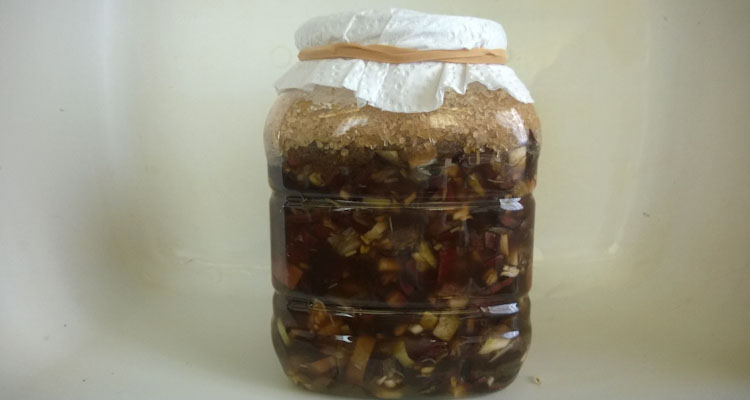
Note: Ideally, the mixture should fill about 2/3 of the container. This amount allows enough space for the air required in the fermentation process while limiting mold growth. Don't worry if it has more than this initially. It will reduce significantly within the first 24 hours.
4. Ferment mixture
Place the container in a dark, well-ventilated area, such as a cupboard or a large cardboard box. Avoid moldy or damp areas.
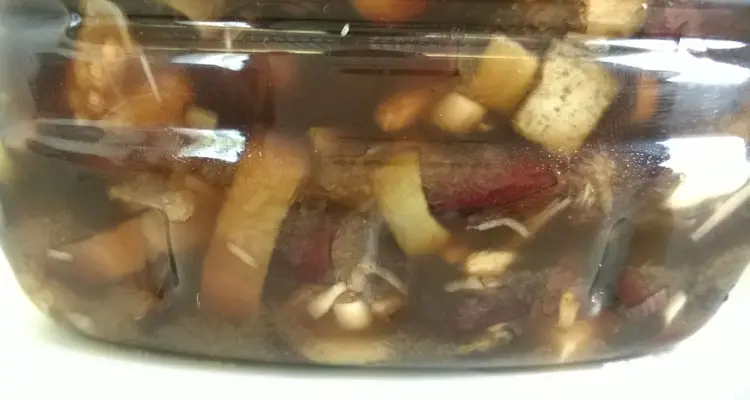
You will smell a faint, sour-sweet scent coming from the solution during the fermentation process. You might even see bubbles at some point.
Based on the temperature, this process can last between 5 to 10 days. At this point, the liquid would have separated from the plant material.
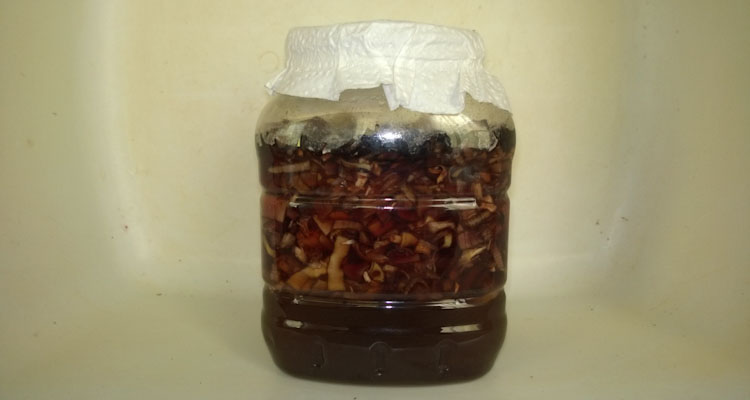
Note: Do not open or stir the mixture during the fermentation process.
5. Strain And Store
Pour the FPJ liquid into the storage jar or bottle using a strainer or sieve cloth to prevent solid particles entering.
Cover the storage container with a paper towel, securing it with a rubber band or string. A glass container is ideal, but food-safe plastic is also suitable.
Place the container into a dark, well-ventilated area, monitoring it periodically. If you notice bubbles forming in the FPJ, add more brown sugar to the solution.
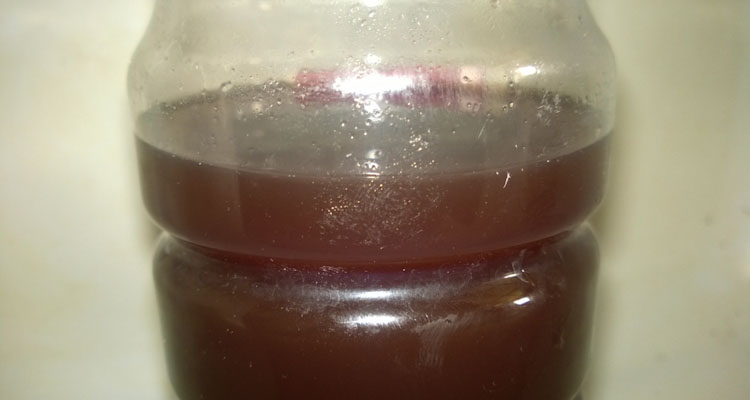
Note: It is crucial to ferment and store FPJ in the dark, well-ventilated areas to prevent harmful organisms from multiplying. You can add water to the left-over plant material to produce vinegar.
What Are The Best Plants For FPJ?
The best plants for FPJ are fast-growing, non-poisonous plants that you can find within your area. There are some popular options, such as banana blossoms and Moringa leaves.
Here is a list of some common plants used to make Fermented Plant Juice. I’ve included some of their scientific names since common names may differ from country to country.
| Common Name | Scientific Name |
| Purslane | Portulaca oleracea |
| Moringa | Moringa oleifera |
| Banana | Various Types |
| Seaweed | Various Types |
| Bamboo | Various Types |
| Beans | Various Types |
| Noni | Morida citrifolia |
| Sweet Potato Shoots | Ipomoea batatas |
| Pumpkin, Cucumber Shoots | Cucurbita spp. |
| Vegetables | Various Types |
Note: From the list above, it is safe to say that you can use just about any plant in your garden, provided they are not poisonous. Check out our Plant Guide for more ideas.
Uses And Benefits Of Fermented Plant Juice
FPJ contains beneficial microorganisms and most nutrients present in the source materials. It can boost vegetative growth and reportedly helps improve the taste of fruiting plants if applied at the right time.
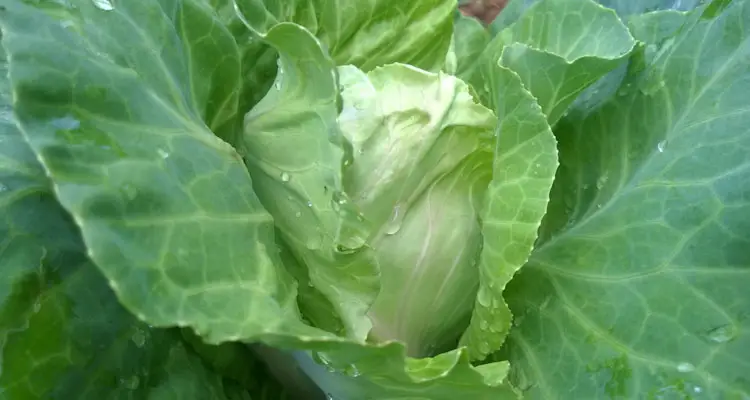
Fermented Plant Juice is an ideal source of bio-available nutrients needed by growing plants. It helps to strengthen cells, protecting the plant from harmful organisms. It serves as a probiotic for livestock and natural pest control, a distracting pest from target plants.
The plant’s Nutritive Cycle guides the use of Fermented Plant Juice in Korean Natural Farming. You can apply FPJ to young plants, providing them with the necessary nutrients for vigorous, healthy growth. In this case, FPJ made from similar plants would be perfect.
However, you should avoid applying it to already overgrown plants, experiencing a growth spurt, or growing in areas prone to fungal diseases.
Fermented Plant Juice can help animals with digestion issues and is fed to livestock such as chickens, goats, and cattle. We can also benefit from this probiotic property, provided we follow food safety procedures while preparing it.
How Do You Apply FPJ?
Fermented Plant Juice is concentrated and becomes even more so over time. It must be diluted and then applied either as a foliar spray or sprinkled directly onto the soil.
Ideally, you should mix FPJ with water in a ratio of at least 1:1000 (1 part FPJ to 1000 parts water). This ratio equates to about 2 teaspoons of FPJ to 1 liter of water.
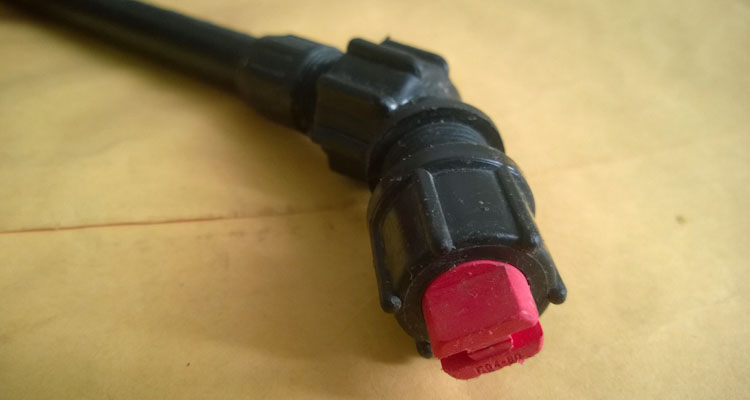
You should apply Fermented Plant Juice once a week to plants in their early stage of the Nutritive Cycle when experiencing vigorous growth. However, you should discontinue its use as the plants start to flower.
You will need to monitor your plants carefully and adjust the concentration of the FPJ as required. In some instances, you will have to use double the amount of FPJ to give the plants a boost.
For animals, you should mix 2 tablespoons of FPJ to 1 liter of water. This mixture should be given to the animal twice per week. Alternatively, you can add it to their food.
Note: It is best to apply FPJ in the evenings, or at least when the sunlit is not too intense, to avoid watermarks and premature evaporation,
Disadvantages Of Fermented Plant Juice
While Fermented Plant Juice is undoubtedly helpful, you need to be aware of some disadvantages. They are mainly due to the ingredients and not the actual solution itself.
Fermented Plant Juice requires brown sugar to ferment. However, there will be times of scarcity in countries where sugar is imported. As a result, it is sometimes challenging to make FPJ and any Korean Natural Farming concoction that depends on sugar.
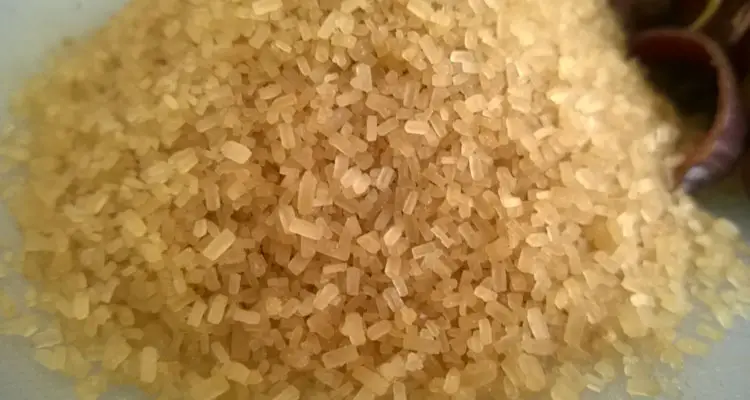
For example, I learned about Korean Natural Farming during a brown sugar shortage, which continued for about 3 months on our island. Thankfully, my research led me to JADAM Organic Farming, which allowed me to produce the necessary inputs for my farm.
The quality of the FPJ depends on the source material. If the plants were contaminated or picked at an inappropriate time, these negative attributes would pass onto the target plants.
Ensure you are careful when and where you collect your plant materials. Avoid collecting plants close to the roadside or immediately after heavy rains.
Final Thoughts
Irrefutable evidence that Fermented Plant Juice works if prepared and applied correctly. It is most effective when used with other Korean Natural Farming inputs, following the plant’s Nutritive Cycle.
Ideally, you should use Fermented Plant Juice made from the plant you intend to use it on. It should be applied regularly when the plant is young but avoided in instances of overgrowth.
FPJ is easy to make but relies on imported brown sugar, which experiences scarcity from time to time. While this is not a deal-breaker, it is an inconvenience you need to bear in mind.
Related Questions
Is Fermented Plant Juice A Fertilizer?
Fermented Plant Juice is a bio-fertilizer containing both macro and micronutrients needed by plants. It includes a mixture of fermented plant extract and various microorganisms, resulting in a potent source of bios available nutrients.
How Long Does Fermented Plant Juice Last?
Fermented Plant Juice can last up to 30 days at average room temperature and up to a year if kept refrigerated, between 1°C to 15°C. You can extend the shelf life of the solution by adding more brown sugar to the mixture and keeping it in a cool dark area.
References
Cho’s Global Natural Farming. Fermented Plant Juice. cgnfindia.com. Access May 2022
Reddy, Ronhini. Cho’s Natural Farming. South Asian Rural Reconstruction Association. 2011 (PDF)
